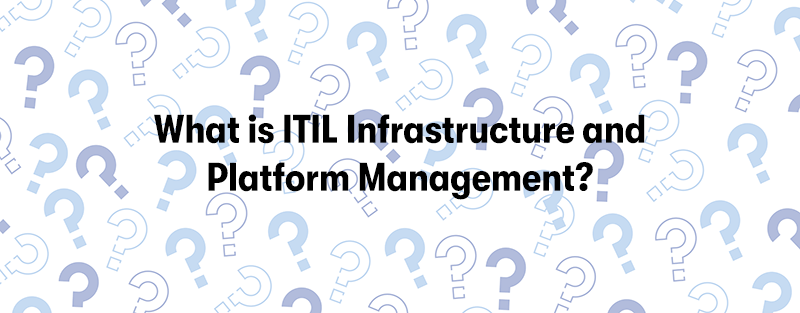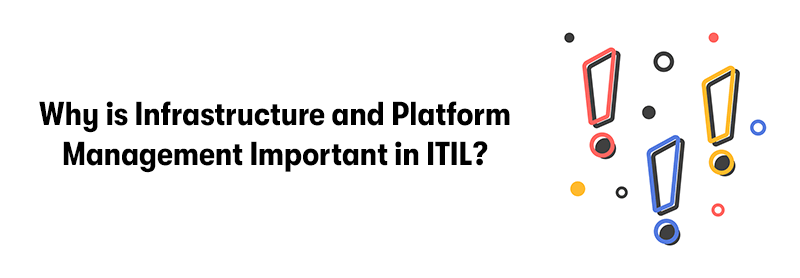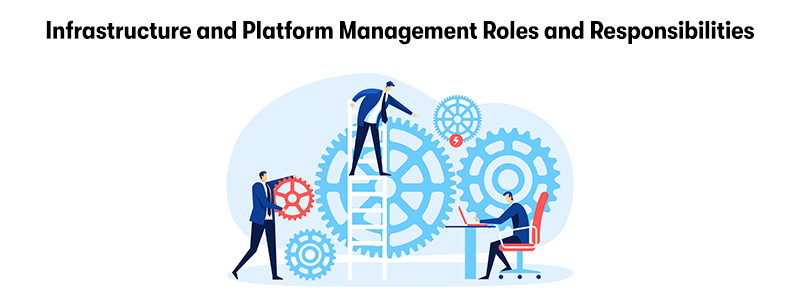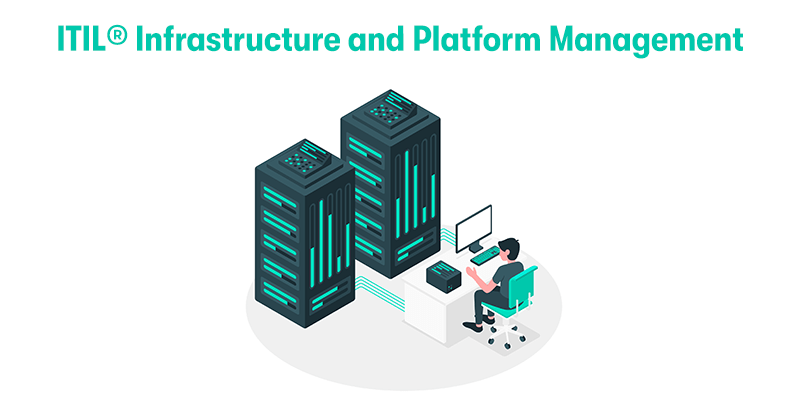ITIL® Infrastructure and Platform Management
Welcome to our blog on ITIL Infrastructure and Platform Management! In this post, we'll explore the critical role of Infrastructure and Platform Management within the ITIL4 framework.
ITIL (formerly the Information Technology Infrastructure Library) is a globally recognised set of best practices for IT service management. ITIL4 is the latest version, designed to address the evolving needs of modern businesses in the digital era. At its core, ITIL4 focuses on creating value through IT services, and Infrastructure and Platform Management is a key component of this value delivery.
Infrastructure and Platform Management involves overseeing an organisation's technology infrastructure, including hardware, software, networking, and cloud-based platforms. It ensures that these components align with business objectives, support efficient service delivery, and maintain high performance, security, and reliability.
In this blog, we'll delve into the key roles, responsibilities, and practices associated with ITIL Infrastructure and Platform Management. We'll explore how it enhances service stability, resource optimisation, risk management, and user experience. Join us on this journey to understand how ITIL4's Infrastructure and Platform Management can propel your organisation towards greater success in the ever-changing digital landscape. Let's get started!
What is ITIL Infrastructure and Platform Management?

The infrastructure and platform management practice plays a critical role within an organisation's IT service management strategy. Its primary objective is to provide comprehensive oversight and governance over the infrastructure and platforms employed by the organisation. By effectively executing this practice, the organisation gains the capability to monitor and control the entire spectrum of technology solutions at its disposal, encompassing both internal infrastructure and external service providers.
At its core, this practice involves a systematic approach to the planning, deployment, operation, and continual improvement of all infrastructure elements and technology platforms. It entails meticulous coordination and collaboration across various teams, such as IT operations, development, security, and procurement, to ensure seamless integration and optimal utilisation of resources.
The first key aspect of this practice involves mapping out the technology landscape of the organisation. It necessitates a comprehensive inventory of all hardware, software, networking components, and cloud-based services utilised to support the delivery of IT services. This step enables a clear understanding of the organisation's technological assets and lays the foundation for efficient management.
Once the technology landscape is documented, the practice focuses on ensuring that the infrastructure and platforms align with the organisation's business objectives and service requirements. By closely evaluating these aspects, IT leaders can make informed decisions about technology investments, upgrades, and decommissioning obsolete systems. The goal is to maintain a future-proof, agile, and cost-effective technology environment that can readily adapt to changing business needs.
What is the Objective of Infrastructure and Platform Management?

The objective of Infrastructure and Platform Management is to ensure the effective and efficient oversight, governance, and control of an organisation's technology infrastructure and platforms throughout their lifecycle. This practice is a critical component of IT service management and focuses on managing the hardware, software, networking components, and cloud-based services that support the organisation's IT services and business operations. The key objectives of Infrastructure and Platform Management include:
Optimal Performance and Reliability
The primary aim is to ensure that the infrastructure and platforms perform at their best and meet the organisation's performance and reliability requirements. This involves regular monitoring, proactive maintenance, and timely upgrades to avoid service disruptions and deliver a seamless user experience.
Alignment with Business Objectives
The practice strives to align technology infrastructure and platforms with the organisation's overall business objectives. This means that IT leaders must understand the business needs and ensure that the technology components are capable of supporting and enabling the achievement of those objectives.
Cost Optimisation
Infrastructure and Platform Management aims to optimise costs associated with technology assets. This involves making informed decisions about technology investments, resource allocation, and eliminating inefficiencies in the infrastructure to maximise return on investment (ROI).
Risk Management and Security
Another crucial objective is to manage risks related to the infrastructure and platforms. This includes implementing robust security measures, conducting regular risk assessments, and ensuring compliance with industry standards and regulations to protect the organisation's data and systems from cyber threats.
Effective Vendor Management
The practice involves engaging with external service providers, such as cloud vendors or technology partners. The objective is to establish and manage service level agreements (SLAs) effectively, ensure compliance with contractual obligations, and continuously evaluate the performance of vendors.
Continual Improvement
Infrastructure and Platform Management emphasises a culture of continual improvement. Regular reviews, retrospectives, and feedback loops enable IT teams to identify areas for enhancement, streamline processes, and adapt to changing technology trends and business requirements.
Scalability and Flexibility
The objective is to build an infrastructure and platform ecosystem that is scalable and flexible enough to accommodate future growth and technological advancements. This enables the organisation to quickly adapt to changing market conditions and take advantage of emerging opportunities.
Resource Optimisation
The practice aims to optimise the utilisation of resources, including hardware, software licenses, and cloud services. This involves monitoring resource consumption and making data-driven decisions to ensure optimal resource allocation.
Enhanced User Experience
Infrastructure and Platform Management strives to deliver a positive user experience for both employees and customers. By ensuring reliable and high-performance technology services, users can interact with applications and systems efficiently, leading to increased productivity and satisfaction.
Why is Infrastructure and Platform Management Important in ITIL?

Infrastructure and Platform Management plays a critical role in supporting the overall IT service delivery and ensuring the alignment of IT with business objectives. Here are some key reasons why Infrastructure and Platform Management is vital in ITIL:
Stability and Reliability
Effective Infrastructure and Platform Management ensures that the technology infrastructure and platforms are stable and reliable. By proactively monitoring and maintaining the infrastructure components, organisations can reduce the risk of service disruptions and downtime, leading to improved service availability and user satisfaction.
Service Continuity
Infrastructure and Platform Management supports the continuity of IT services. It involves establishing robust disaster recovery and business continuity plans, ensuring that critical services can be quickly restored in the event of unexpected incidents or disasters.
Cost Optimisation
Through efficient management of infrastructure and platforms, organisations can optimise costs associated with IT resources. This involves making informed decisions about technology investments, resource allocation, and eliminating unnecessary expenses, contributing to cost-effectiveness.
Alignment with Business Needs
The practice ensures that the technology infrastructure and platforms align with the organisation's business objectives. This alignment is crucial to enable the organisation to meet its strategic goals and support business growth effectively.
Risk Management and Security
Infrastructure and Platform Management focuses on managing risks associated with IT assets and services. This includes implementing appropriate security measures and ensuring compliance with regulatory requirements to protect the organisation from potential cybersecurity threats.
Efficient Resource Utilisation
By monitoring resource consumption and optimising resource allocation, organisations can use their IT assets more efficiently. This leads to better utilisation of hardware, software licenses, and cloud services, reducing waste and unnecessary expenditures.
Vendor Management
Infrastructure and Platform Management involves engaging with external service providers, such as cloud vendors or technology partners. By effectively managing vendor relationships and SLAs, organisations can ensure that external services meet their performance expectations.
Adaptability to Change
With proper Infrastructure and Platform Management, organisations can be more adaptable to changes in business requirements and technology trends. The practice fosters a culture of continuous improvement, allowing the organisation to evolve and innovate as needed.
Service Level Management
Infrastructure and Platform Management supports the establishment and monitoring of service level agreements (SLAs). By meeting SLA targets for infrastructure and platforms, organisations can deliver reliable services to their users.
Enhanced User Experience
A well-managed infrastructure and platform environment contribute to a positive user experience. Reliable and high-performance IT services improve employee productivity and customer satisfaction.
What is Important to Understand About ITIL Infrastructure and Platform Management?
Understanding ITIL Infrastructure and Platform Management is crucial for organisations looking to effectively manage their technology infrastructure and platforms to deliver reliable and high-quality IT services. Here are some important points to grasp about ITIL Infrastructure and Platform Management:
IT Service Alignment
Infrastructure and Platform Management is closely tied to the overall IT service management strategy. It emphasises aligning the technology infrastructure and platforms with the organisation's business objectives to ensure that IT services support and contribute to the achievement of business goals.
Service Lifecycle Management
The practice covers the entire lifecycle of technology infrastructure and platforms, from planning and design to deployment, operation, and continual improvement. Each stage of the lifecycle requires careful consideration to deliver optimal performance and value.
Service Availability and Reliability
Ensuring the availability and reliability of IT services is a core objective of Infrastructure and Platform Management. Proactive monitoring, fault detection, and maintenance are essential to minimise service disruptions and downtime.
Risk Management and Security
The practice incorporates risk management and security measures to protect the organisation's data, systems, and operations from potential threats. IT teams must be vigilant in implementing security controls and complying with relevant regulations.
Resource Optimisation
Infrastructure and Platform Management seeks to optimise the utilisation of IT resources, such as hardware, software, and cloud services, to minimise waste and unnecessary expenses while maintaining service quality.
Vendor Management
Engaging with external service providers, such as cloud vendors or technology partners, requires effective vendor management. This involves establishing clear service level agreements (SLAs) and regularly evaluating vendor performance.
Continual Improvement
A culture of continual improvement is central to Infrastructure and Platform Management. Regular reviews, assessments, and feedback loops enable IT teams to identify areas for enhancement and enhance the overall IT service delivery.
User-Centric Approach
ITIL emphasises a user-centric approach to service management. Understanding and meeting the needs of users, whether they are employees or customers, is essential to providing a positive user experience.
ITIL Practices Integration
Infrastructure and Platform Management should be integrated with other ITIL practices and processes, such as Incident Management, Change Management, and Problem Management, to ensure a cohesive and well-coordinated IT service delivery.
Business Impact
ITIL Infrastructure and Platform Management recognises the business impact of technology services. It involves monitoring and reporting on key performance indicators (KPIs) to demonstrate the value of IT services to the organisation.
Flexibility and Adaptability
The practice acknowledges the dynamic nature of technology and business requirements. IT teams must be flexible and adaptive to meet changing demands and leverage emerging technologies effectively.
IT Governance and Compliance
Infrastructure and Platform Management contributes to IT governance by ensuring that technology assets and services are managed in compliance with relevant policies, regulations, and industry standards.
Infrastructure and Platform Management Roles and Responsibilities

In ITIL 4, Infrastructure and Platform Management roles and responsibilities are distributed across various teams and individuals within the organisation. The specific roles and their responsibilities may vary depending on the organisation's size, structure, and IT service management maturity level. Here are some key roles and their associated responsibilities:
IT Infrastructure Manager:
The IT Infrastructure Manager oversees the entire IT infrastructure and platform management function. Their responsibilities include:
- Defining the overall strategy and roadmap for managing infrastructure and platforms.
- Ensuring alignment of infrastructure and platform initiatives with business objectives.
- Establishing and managing budgets for infrastructure projects and ongoing operations.
- Collaborating with other IT and business leaders to ensure IT services meet stakeholder needs.
- Evaluating new technologies and tools to improve infrastructure efficiency and performance.
- Leading the implementation of ITIL practices related to infrastructure and platform management.
Infrastructure Architects:
Infrastructure architects are responsible for designing and planning the organisation's IT infrastructure. Their responsibilities include:
- Creating blueprints for technology infrastructure and platform components.
- Identifying hardware, software, and networking requirements to support business needs.
- Ensuring that infrastructure designs align with industry best practices and security standards.
- Collaborating with other IT teams to integrate infrastructure components effectively.
IT Operations Manager:
The IT Operations Manager oversees the day-to-day operations of the IT infrastructure and platforms. Their responsibilities include:
- Monitoring the performance and health of IT infrastructure and platforms.
- Implementing incident, problem, and change management processes to address issues.
- Coordinating with IT support teams to resolve incidents and minimise service disruptions.
- Ensuring compliance with service level agreements (SLAs) and key performance indicators (KPIs).
Platform Administrators:
Platform administrators are responsible for managing specific technology platforms and services. Their responsibilities include:
- Configuring and maintaining software applications and platforms.
- Applying patches and updates to keep platforms secure and up-to-date.
- Monitoring platform performance and identifying potential issues.
- Supporting end-users in utilising platform functionalities effectively.
Security and Compliance Specialists:
These specialists focus on security and compliance aspects related to infrastructure and platforms. Their responsibilities include:
- Implementing security measures to safeguard IT infrastructure and data.
- Conducting risk assessments and vulnerability scans to identify security gaps.
- Ensuring compliance with relevant regulations, industry standards, and organisational policies.
- Collaborating with IT and business stakeholders to address security and compliance concerns.
Service Desk and Incident Management Team:
The service desk and incident management team handle incoming incidents and service requests related to infrastructure and platforms. Their responsibilities include:
- Logging and categorising incidents reported by users.
- Providing initial support and troubleshooting for infrastructure-related issues.
- Escalating complex incidents to appropriate teams for resolution.
It's important to note that the roles and responsibilities listed above can be tailored and adjusted based on an organisation's specific needs and organisational structure. Effective collaboration and communication among these roles are essential to ensure smooth IT service delivery and ongoing improvement of infrastructure and platform management practices within the organisation.
Final Notes on Infrastructure and Platform Management for ITIL
In conclusion, ITIL Infrastructure and Platform Management is the backbone of effective IT service delivery.
By aligning technology with business objectives, optimising resources, and ensuring reliability and security, organisations can thrive in the digital age. Key roles, such as IT Infrastructure Manager, Architects, and Platform Administrators, play vital roles in this process. Emphasising continual improvement, risk management, and user-centricity, Infrastructure and Platform Management empowers businesses to adapt to changing demands and deliver exceptional services.
With ITIL's best practices guiding the way, organisations can build a robust, agile, and customer-focused IT environment that drives success and competitiveness in today's dynamic landscape.


